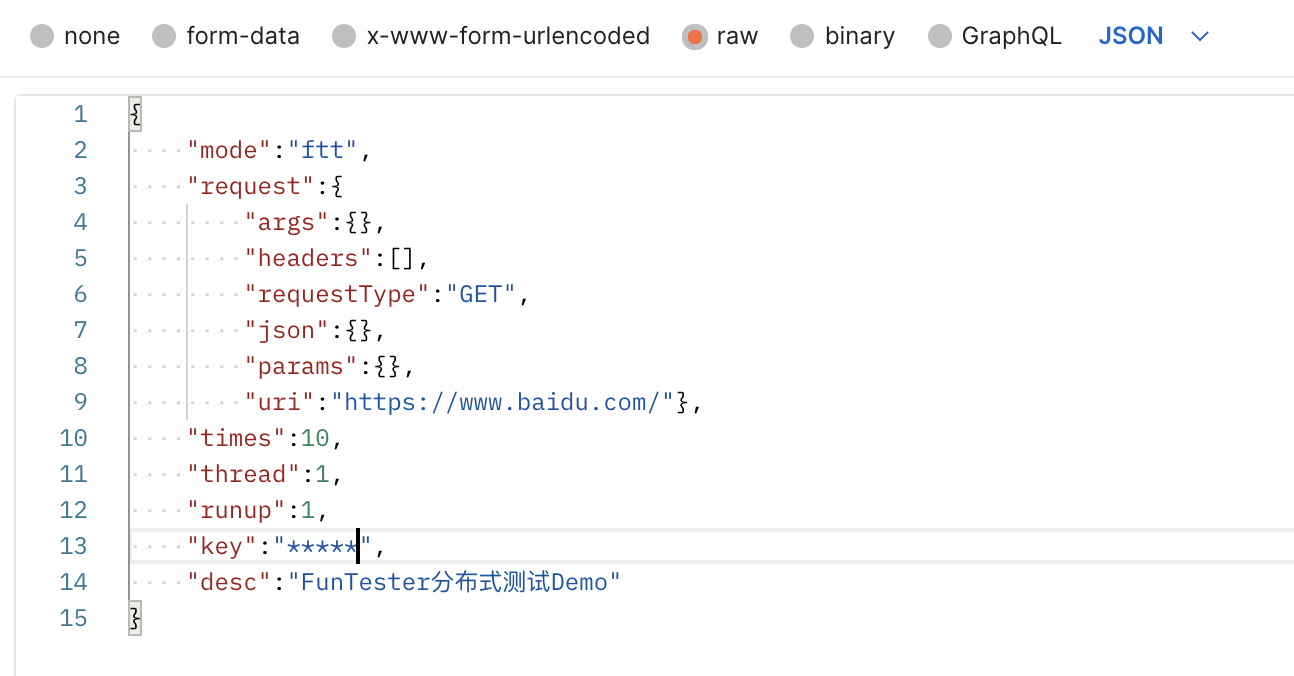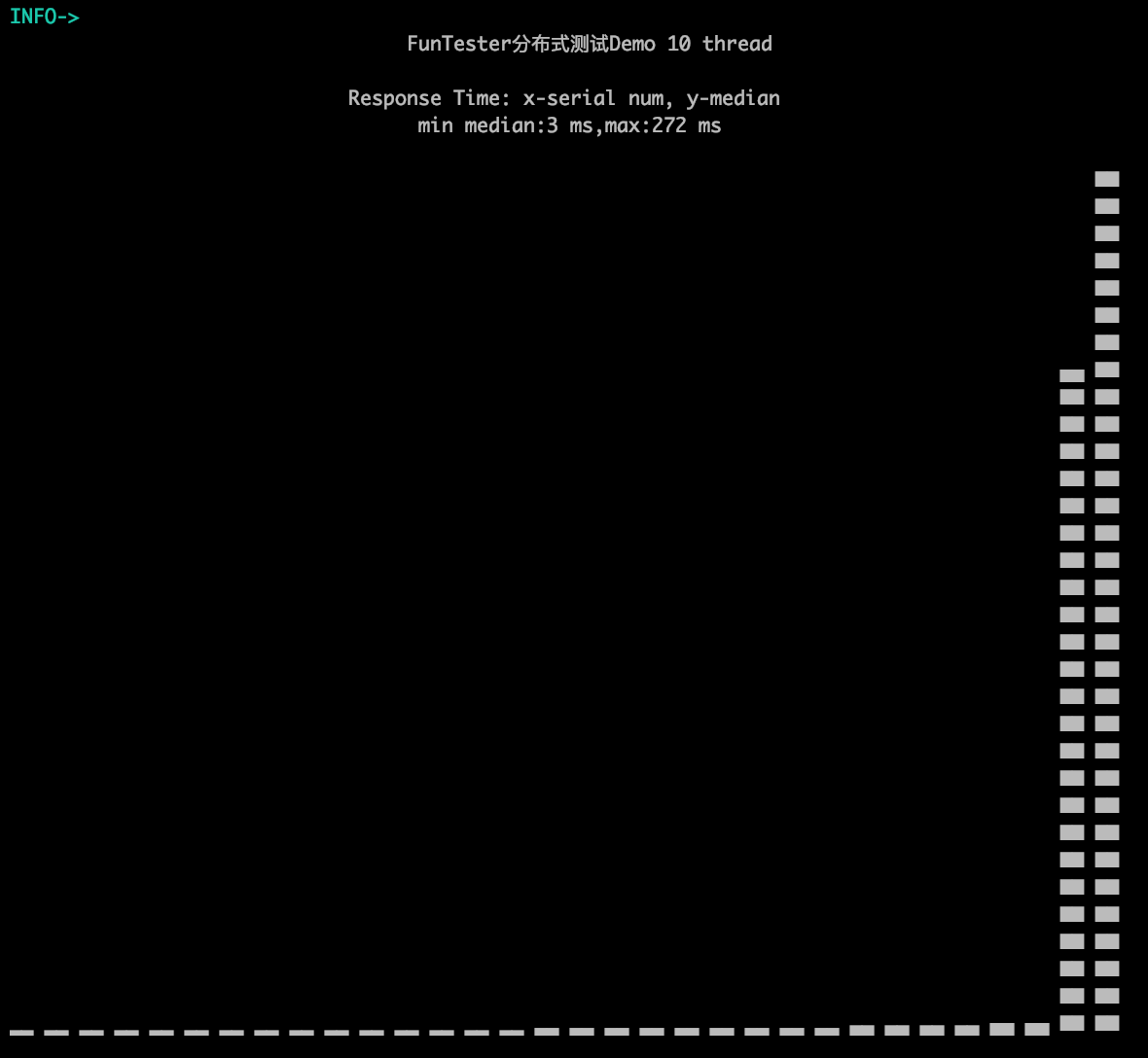在经过这么久的铺垫,FunTester测试框架分布式版本的工作正式开始了,我首先写了一个单节点的版本,通过HTTP协议接口进行任务上传,而非像之前设想中的,定时去master节点进行pull任务。
此版本为单节点部署,可本地部署,预计下个月开源,主要是考虑到版本不稳定,肯定会进行多轮更改。
当前服务只是针对之前设想的方案(一)(基于HttpRequestBase对象)进行实践,感兴趣的童鞋可以翻看旧文章:
至于方案(二)(基于jar包方法模板)和方案(三)(基于Java/Groovy测试脚本)的设想、验证以及实现,后续会慢慢推出。PS:没看错,我已经找找了执行Java测试脚本的方法。
欢迎大家在使用过程中,多提提意见,多提提需求,当然多多宣传也行。
自费服务器,大家以体验为主。以后实际使用以本地部署为主,公网依然以体验为主,这个服务器费用还是有点贵的。
内测阶段,访问密钥请联系FunTester作者本人,改接口文档可能会有所变化,请及时关注FunTester,获取最新动态。我用postman导出了一份测试Demo(含测试密钥),有兴趣的同学请联系作者本人获取。
接口文档
接口地址:http://124.70.188.11:8080/test/post
请求方式:POST
传参格式:JSON(application/json)
参数
| 参数 | 类型 | 限制 | 备注 |
|---|---|---|---|
| times | int | ||
| thread | int | ||
| mode | String | 默认ftt | |
| desc | String | 任务描述 | |
| runup | int | 软启动时间 | |
| key | String | 访问秘钥,找FunTester作者要 | |
| request | String | 被测请求,格式如下 |
非Java语言补充
request也可以通过JSON对象上传参数,文档如下:
| 参数 | 类型 | 限制 | 备注 |
|---|---|---|---|
| requestType | String | 请求类型,目前GET/POST | |
| uri | String | 请求地址 | |
| args | JSON | GET请求参数 | |
| json | JSON | POST请求JSON参数 | |
| params | JSON | POST请求form表单参数 | |
| headers | JSONarray | 请求headers(key-value) |
postman截图

请求参数Demo
{
"mode":"ftt",
"request":{
"args":{},
"headers":[],
"requestType":"GET",
"json":{},
"params":{},
"uri":"待测接口地址"},
"times":10,
"thread":1,
"runup":1,
"key":"funtester2021",
"desc":"FunTester分布式测试Demo"
}
Java版本--基于FunTester
这个版本用了com.funtester.httpclient.FunRequest类,所以需要下载FunTester测试框架的主git项目,地址如下:https://gitee.com/fanapi/tester,分支oker。
import com.alibaba.fastjson.JSONObject;
import com.funtester.httpclient.ClientManage;
import com.funtester.httpclient.FunLibrary;
import com.funtester.httpclient.FunRequest;
import com.funtester.utils.DecodeEncode;
import org.apache.http.client.methods.HttpGet;
import org.apache.http.client.methods.HttpPost;
public class PerSerTest extends FunLibrary {
public static void main(String[] args) {
ClientManage.init(100, 100, 0, EMPTY, 0);
JSONObject res = new JSONObject();
res.put("times", 100);
res.put("thread", 10);
res.put("key", "");
res.put("mode", "ftt");
res.put("desc", "FunTester分布式测试Demo");
res.put("runup", 10);
String url = "http://待测接口";
HttpGet get = FunLibrary.getHttpGet(url);
FunRequest request = FunRequest.initFromRequest(get);
res.put("request", request.toJson());
HttpPost httpPost = getHttpPost("http://124.70.188.11:8080/test/post", res.toString());
JSONObject response = getHttpResponse(httpPost);
output(response);
String table = response.getJSONObject("data").getString("table");
output(DecodeEncode.unzipBase64(table));
}
}
Java版本--通用版
这个版本将所有的参数都用JSON格式,Python版本的也参考这个构建请求参数。我Python已经生疏,由于时间关系,我等其他大佬实现了之后会做分享。
import com.alibaba.fastjson.JSONArray;
import com.alibaba.fastjson.JSONObject;
import com.funtester.httpclient.ClientManage;
import com.funtester.httpclient.FunLibrary;
import com.funtester.utils.DecodeEncode;
import org.apache.http.client.methods.HttpPost;
public class PerSerTest2 extends FunLibrary {
public static void main(String[] args) {
ClientManage.init(100, 100, 0, EMPTY, 0);
JSONObject res = new JSONObject();
res.put("times", 10);
res.put("thread", 10);
res.put("key", "");
res.put("mode", "ftt");
res.put("desc", "FunTester分布式测试Demo");
res.put("runup", 10);
JSONObject re = new JSONObject();
re.put("requestType", "GET");
re.put("uri", "http://待测接口");
re.put("args", new JSONObject());
re.put("json", new JSONObject());
re.put("params", new JSONObject());
re.put("headers", new JSONArray());
res.put("request", re);
HttpPost httpPost = getHttpPost("http://124.70.188.11:8080/test/post", res.toString());
JSONObject response = getHttpResponse(httpPost);
output(response);
String table = response.getJSONObject("data").getString("table");
output(DecodeEncode.unzipBase64(table));
}
}
Groovy版本
我给Groovy的一个定义就是快速构建测试脚本,这里非常明显差异,对比以上两种Java版本的代码,Groovy非常简单。
import com.alibaba.fastjson.JSONObject
import com.funtester.httpclient.ClientManage
import com.funtester.httpclient.FunLibrary
import com.funtester.httpclient.FunRequest
class PerSerTest extends FunLibrary {
public static void main(String[] args) {
ClientManage.init(100,100,0,EMPTY,0)
def res = new JSONObject()
res.times = 100
res.thread = 10
res.key = ""
res.mode = "ftt"
res.desc = "FunTester分布式测试Demo"
res.runup = 10
String url = "http://"
def get = FunLibrary.getHttpGet(url)
def request = FunRequest.initFromRequest(get)
res.request = request.toJson()
def get1 = getHttpPost("http://124.70.188.11:8080/test/post",res.toString())
def response = getHttpResponse(get1)
output(response)
}
}
接口响应
接口响应是一个JSON对象,也是一个com.funtester.base.bean.PerformanceResultBean对象,后面我会奉上代码,这里先看见控制台输出。
INFO-> 请求uri:http://124.70.188.11:8080/test/post , 耗时:14217 ms , HTTPcode: 200
INFO->
~☢~~☢~~☢~~☢~~☢~~☢~~☢~~☢~~☢~~☢~ JSON ~☢~~☢~~☢~~☢~~☢~~☢~~☢~~☢~~☢~~☢~
> {
> ① . "code":0,
> ① . "data":{
> ② . . . "rt":18,
> ② . . . "failRate":0.0,
> ② . . . "threads":10,
> ② . . . "deviation":"53.29%",
> ② . . . "qps2":259.4752186588921,
> ② . . . "errorRate":0.0,
> ② . . . "executeTotal":801,
> ② . . . "total":1801,
> ② . . . "qps":555.5555555555555,
> ② . . . "startTime":"2021-06-01 18:09:17",
> ② . . . "endTime":"2021-06-01 18:09:20",
> ② . . . "mark":"FunTester分布式测试Demo011809",
> ② . . . "table":"eJzj5VIgCNxK80JSi0tSi552tD3d0fx0T/+zrd0v1k91Sc3NVzA0UCjJKEpNTCFsDi8XL37bglKLC/LzilMVQjJzU60UKnSLU4syE3MU8kpzdRQqdXNTUzIT8wjZQdgdCrmZeQoQw6yMFXKLdXITK6yMzI2ATCI0E/QFpeDRtA4gIs4no7aM2jJIbXk0rRWI6GMT2IpRm0ZtGrVp1KZRm0ZtGrVp1KZRm7DY9GhaExAp0INqBiIKqBYgwkVBW5bIDUy4DwEIcgne"
> ① . },
> ① . "FunTester":200
> }
~☢~~☢~~☢~~☢~~☢~~☢~~☢~~☢~~☢~~☢~ JSON ~☢~~☢~~☢~~☢~~☢~~☢~~☢~~☢~~☢~~☢~
其中最外层的FunTester是框架加上去的,并非真正的响应。data中的内容就是性能测试的结果,也就是com.funtester.base.bean.PerformanceResultBean对象。其中如果想看table内容的话,需要添加两行代码:
String table = response.getJSONObject("data").getString("table");
output(DecodeEncode.unzipBase64(table));
控制台输出如下:

com.funtester.base.bean.PerformanceResultBean
package com.funtester.base.bean
import com.funtester.db.mysql.MySqlTest
import com.funtester.frame.Output
import com.funtester.utils.DecodeEncode
/**
* 性能测试结果集
*/
class PerformanceResultBean extends AbstractBean implements Serializable {
private static final long serialVersionUID = -1595942562342357L;
/**
* 测试用例描述
*/
String mark
/**
* 开始时间
*/
String startTime
/**
* 结束时间
*/
String endTime
/**
* 表格信息
*/
String table
/**
* 线程数
*/
int threads
/**
* 总请求次数
*/
int total
/**
* 平均响应时间
*/
int rt
/**
* 吞吐量,公式为QPS=Thead/avg(time)
*/
double qps
/**
* 通过QPS=count(r)/T公式计算得到的QPS,在固定QPS模式中,这个值来源于预设QPS
*/
double qps2
/**
* 理论误差,两种统计模式
*/
String deviation
/**
* 错误率
*/
double errorRate
/**
* 失败率
*/
double failRate
/**
* 执行总数
*/
int executeTotal
PerformanceResultBean(String mark, String startTime, String endTime, int threads, int total, int rt, double qps, double qps2, double errorRate, double failRate, int executeTotal, String table) {
this.mark = mark
this.startTime = startTime
this.endTime = endTime
this.threads = threads
this.total = total
this.rt = rt
this.qps = qps
this.qps2 = qps2
this.errorRate = errorRate
this.failRate = failRate
this.executeTotal = executeTotal
this.table = DecodeEncode.zipBase64(table)
this.deviation = com.funtester.frame.SourceCode.getPercent(Math.abs(qps - qps2) * 100 / Math.max(qps, qps2))
Output.output(this.toJson())
Output.output(table)
MySqlTest.savePerformanceBean(this)
}
}